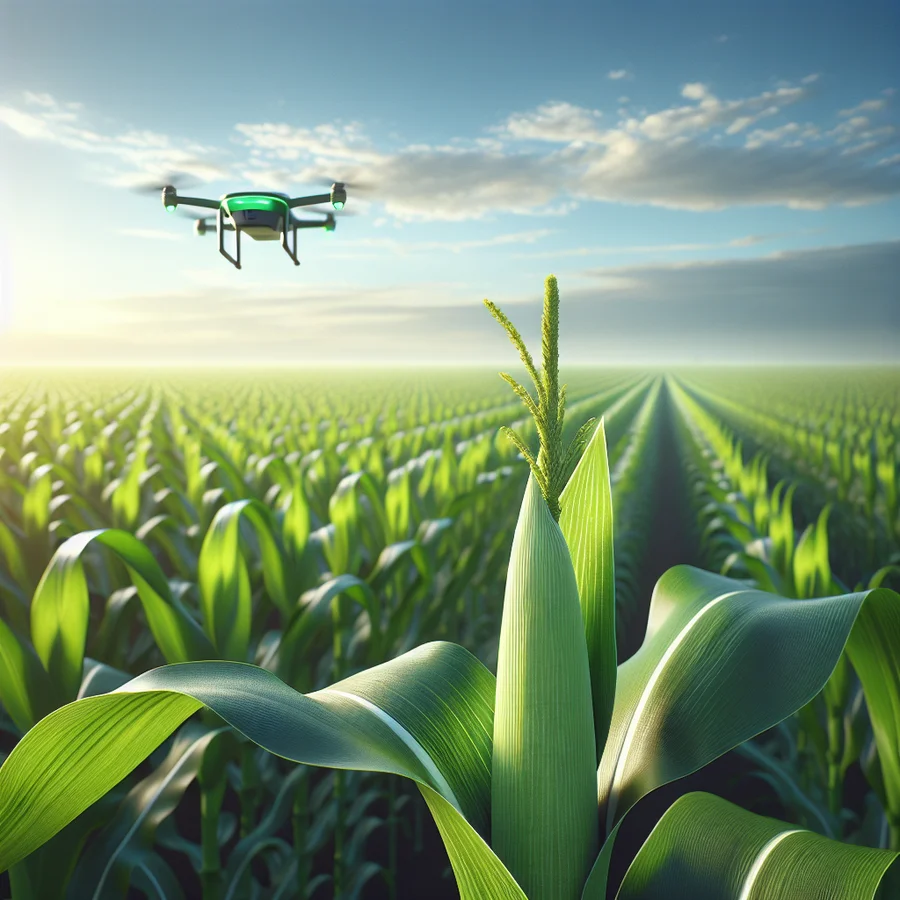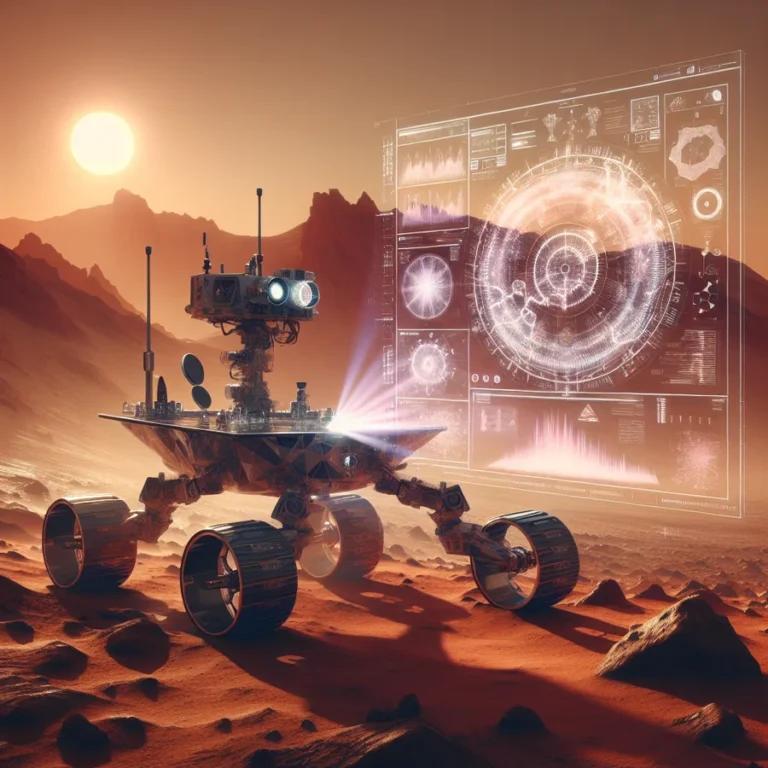AI in Agriculture Technology: Enhancing Crop Yield and Reducing Waste
Agriculture stands as the bedrock of human civilization. As the global population surges and climate challenges intensify, the need for sustainable and efficient farming practices becomes ever more critical. AI in agriculture technology is revolutionizing the industry. It reduces waste, optimizes resource use, and enhances overall efficiency.
This guide explores how AI in agriculture technology is reshaping farming. We’ll cover everything from AI-powered precision agriculture to smart irrigation systems. Discover how these innovations boost crop yields, minimize waste, and pave the way for a more sustainable future.
Understanding the Role of AI in Agriculture Technology
Artificial Intelligence (AI) involves machines mimicking human intelligence. These machines are programmed to think, learn, and make decisions. AI in agriculture technology uses these capabilities to analyze data, predict outcomes, and automate processes. This empowers farmers to make smarter and faster decisions.
Integrating AI in agriculture technology addresses critical issues. These include resource wastage, yield optimization, and environmental impact. AI provides data-driven solutions that improve decision-making and efficiency across the agricultural sector.
Current Challenges in Agriculture
Before exploring the benefits of AI in agriculture technology, let’s understand the challenges the sector faces:
- Inefficient Resource Utilization: Overuse of water, fertilizers, and pesticides leads to waste and environmental harm.
- Climate Change: Unpredictable weather patterns make it hard for farmers to plan effectively.
- Labor Shortages: Many regions face a shrinking agricultural workforce.
- Food Waste: Poor storage and distribution cause significant losses.
- Crop Diseases: Pests and diseases can devastate yields, often undetected until too late.
AI in agriculture technology is uniquely positioned to tackle these challenges. It provides data-driven solutions that enhance decision-making and boost efficiency.
How AI is Reducing Waste in Agriculture
AI in agriculture technology offers numerous solutions to minimize waste. These solutions span various aspects of farming, from resource management to supply chain optimization.
Precision Agriculture and AI’s Role
Precision agriculture leverages AI in agriculture technology to optimize resource use. AI-powered tools analyze data from sensors, satellites, and drones. This data monitors soil health, crop growth, and weather conditions. Farmers can then apply water, fertilizers, and pesticides precisely where needed, minimizing waste.
For example, AI can analyze soil composition. It detects imbalances in nutrients or pH levels. Addressing these issues early optimizes soil health and improves crop production. This also minimizes the need for chemical fertilizers.
Crop Monitoring with AI
AI in agriculture technology enhances crop monitoring through advanced image analysis. AI algorithms analyze images from drones or satellites. This detects early signs of crop stress, pest infestations, or diseases. Timely interventions reduce losses and prevent widespread damage.
For instance, AI can detect apple scab in apple trees or yellow rust in wheat. Early detection allows farmers to apply targeted treatments. This reduces the use of chemicals and prevents crop loss.
Smart Irrigation Systems Using AI
AI in agriculture technology drives smart irrigation systems. These systems optimize water usage by predicting weather conditions. They also assess soil moisture levels. AI-driven systems significantly reduce water wastage, especially in water-scarce regions.
These systems monitor soil moisture in real-time. They adjust water distribution accordingly. This ensures crops receive the right amount of water. It prevents over-irrigation and reduces water waste.
Optimizing the Food Supply Chain with AI
AI in agriculture technology streamlines the food supply chain. It predicts demand, optimizes storage, and reduces spoilage during transportation. This ensures food reaches consumers efficiently, cutting down on waste.
AI systems can track produce from farm to market. They provide real-time data on location, condition, and estimated arrival time. This reduces spoilage during transportation and ensures a steady supply of fresh produce.
AI in Managing Crop Health
AI in agriculture technology helps manage crop health effectively. AI-powered systems detect early signs of disease, pest infestations, and nutrient deficiencies. By identifying issues early, farmers can apply targeted treatments. This reduces chemical use and prevents crop loss, leading to healthier crops and less wasted produce.
AI can detect pests and diseases early, enabling more targeted pesticide applications. This reduces the overall use of chemicals and minimizes their environmental impact.
Reducing Food Spoilage with AI-Powered Solutions
AI in agriculture technology plays a crucial role in the post-harvest phase. It helps reduce food spoilage by monitoring storage conditions. AI algorithms ensure crops remain fresh for longer. AI-based supply chain systems predict demand and optimize distribution. This ensures food reaches consumers before it spoils.
AI can monitor the storage conditions of crops. This helps maintain freshness for extended periods. AI also optimizes logistics by analyzing supply and demand patterns. This prevents overproduction, a major cause of food waste.
Improving Crop Yield through AI
AI in agriculture technology not only reduces waste but also increases efficiency. By harnessing the power of AI, farmers can improve crop yields and maximize their output.
Crop Prediction Models and AI Analytics
AI in agriculture technology uses machine learning to analyze historical data. This includes weather patterns, soil conditions, and crop data. AI predicts future yields, allowing farmers to plan better. They can make informed decisions about planting, irrigation, and harvesting. These predictions also help mitigate risks associated with unpredictable weather.
AI tools analyze historical data and real-time inputs. This helps farmers plan their operations better and meet market demands efficiently.
AI-Based Irrigation Systems for Optimized Water Usage
Water scarcity is a growing concern. AI in agriculture technology helps farmers use water more efficiently. AI-driven irrigation systems monitor soil moisture levels in real-time. They adjust water distribution accordingly, ensuring crops receive the right amount of water. This prevents over-irrigation and reduces water waste.
AI algorithms enable autonomous crop management. When combined with IoT sensors, algorithms can decide how much water to provide to crops in real-time. This conserves water while promoting sustainable agriculture.
Soil Health Monitoring Using AI Technologies
Soil health is the foundation of successful farming. AI in agriculture technology powers sensors that analyze soil composition. These sensors detect imbalances in nutrients or pH levels. By addressing these issues early, farmers can optimize soil health. This improves crop production while minimizing the need for chemical fertilizers.
AI solutions provide real-time insights into soil conditions. This includes nutrient levels and pH. This helps farmers manage soil health for better crop yields and long-term land sustainability.
AI-Powered Farm Machinery and Automation
AI in agriculture technology is transforming physical labor in farming. It automates tasks that were once time-consuming and labor-intensive. This improves efficiency and reduces costs.
Autonomous Tractors and Drones in Farming
AI in agriculture technology drives autonomous tractors and drones. These machines perform tasks like planting, fertilizing, and harvesting without human intervention. They operate more efficiently than traditional machinery. They can work around the clock, increasing productivity.
Automated farm machinery includes driverless tractors, smart irrigation systems, and AI-based greenhouse robots. These tools are more efficient and accurate than human farm workers.
Reducing Labor Costs and Improving Operational Efficiency
Automating tasks with AI in agriculture technology reduces the need for human labor. This can be expensive and hard to find in certain regions. Automation also reduces the risk of human error. It improves operational efficiency, enabling farmers to focus on more strategic tasks.
AI-powered machinery reduces the need for human labor. This automation reduces the risk of human error and improves operational efficiency.
Examples of AI-Powered Machinery in Action
Several companies are deploying AI in agriculture technology. For example, John Deere’s autonomous tractors can plow, plant, and spray crops with minimal human involvement. Drones equipped with AI monitor crop health and deliver fertilizers or pesticides with pinpoint accuracy.
John Deere’s autonomous tractors can plow, plant, and spray crops with minimal human involvement. Drones equipped with AI can monitor crop health and deliver fertilizers or pesticides with pinpoint accuracy.
AI in Supply Chain and Distribution
The agricultural supply chain is another area where AI in agriculture technology makes a significant impact. By improving logistics and inventory management, AI helps reduce waste. It ensures produce reaches consumers in the best condition.
AI in Tracking Produce from Farm to Market
AI in agriculture technology systems track produce from farm to market. They provide real-time data on its location, condition, and estimated arrival time. This reduces spoilage during transportation. It ensures a steady supply of fresh produce.
AI systems track the movement of produce. This reduces the chances of spoilage during transportation. It ensures a steady supply of fresh produce.
Reducing Food Waste Through Better Logistics
AI in agriculture technology optimizes logistics by analyzing supply and demand patterns. It predicts fluctuations in demand, allowing farmers to adjust production and distribution. This prevents overproduction, a major cause of food waste.
AI optimizes logistics by analyzing supply and demand patterns. This prevents overproduction, which is a major cause of food waste.
Smart Inventory Management with AI
AI in agriculture technology powers inventory management systems. These systems help stores and distribution centers track stock levels accurately. By predicting demand and adjusting orders, AI prevents both shortages and excess stock. This reduces food waste.
AI-powered inventory management systems help track stock levels accurately. This prevents both shortages and excess stock, which can lead to food waste.
Environmental Impact of AI in Agriculture
The environmental benefits of AI in agriculture technology are undeniable. By optimizing resource use, reducing waste, and promoting sustainable practices, AI helps create a more eco-friendly agricultural industry.
Minimizing the Carbon Footprint Through AI-Driven Methods
AI in agriculture technology reduces the carbon footprint of agriculture. By using fewer chemicals, reducing water waste, and cutting down on fuel consumption for machinery, AI helps create a more sustainable farming system.
AI’s ability to optimize farming practices reduces the carbon footprint of agriculture. This creates a more sustainable farming system.
AI’s Role in Sustainable Farming Practices
Sustainable farming aims to meet present needs without compromising future generations. AI in agriculture technology contributes to sustainability. It enables farmers to use resources more efficiently. It promotes environmentally friendly farming practices.
AI contributes to sustainability by enabling farmers to use resources more efficiently. It promotes environmentally friendly farming practices.
Reducing the Use of Harmful Pesticides with AI
AI in agriculture technology helps reduce reliance on harmful pesticides. It allows farmers to detect pests and diseases early. This enables more targeted pesticide applications. It reduces the overall use of chemicals and minimizes their environmental impact.
AI helps reduce the reliance on harmful pesticides. This enables more targeted pesticide applications, reducing the overall use of chemicals.
Enhancing Efficiency with AI in Agriculture
AI in agriculture technology enhances efficiency through various applications. These include yield prediction, autonomous machinery, and weather forecasting.
Yield Prediction
AI tools analyze historical data and real-time inputs. This predicts crop yields accurately. This helps farmers plan their operations better and meet market demands efficiently.
Autonomous Machinery
AI-powered tractors, harvesters, and drones automate labor-intensive tasks. These machines work with precision, boosting productivity and reducing human error.
Weather Forecasting
AI models provide highly accurate weather forecasts. This enables farmers to schedule planting, irrigation, and harvesting activities effectively. This reduces the risks of losses due to unpredictable weather events.
Livestock Management
AI systems monitor livestock health and behavior using sensors and cameras. Early detection of illnesses or stress improves animal welfare. It prevents productivity losses.
Benefits of AI Chatbots in Agriculture
AI chatbots offer several benefits to farmers. They provide accessibility, save time, and improve decision-making.
- Accessibility: Farmers gain access to real-time information without needing high-tech devices or expertise.
- Time-Saving: Chatbots handle repetitive inquiries, freeing up farmers to focus on core activities.
- Cost-Effectiveness: AI chatbots are a low-cost solution for providing widespread assistance to farmers in remote regions.
- Improved Decision-Making: By providing timely and accurate information, chatbots empower farmers to make well-informed decisions.
- Scalability: A single chatbot can serve thousands of farmers simultaneously, making it a scalable solution for agricultural challenges.
AI chatbots offer numerous benefits to farmers. They provide accessibility, save time, and improve decision-making.
Applications of AI in Different Farming Practices
AI in agriculture technology has diverse applications across various farming practices. These include crop farming, aquaculture, greenhouse farming, and livestock farming.
Crop Farming
AI optimizes every stage of crop farming, from soil preparation to harvesting. Technologies like machine vision identify pest infestations. Robotic weeders target weeds without damaging crops.
Aquaculture
AI monitors water quality parameters in fish farms. Automated feeding systems powered by AI ensure optimal growth and minimal feed waste.
Greenhouse Farming
AI controls greenhouse environments. It adjusts lighting, temperature, and humidity levels. This ensures ideal conditions for plant growth while minimizing energy consumption.
Livestock Farming
Wearable AI devices track livestock health. AI-powered robots handle feeding and milking tasks efficiently.
Benefits of AI in Agriculture
AI in agriculture technology offers numerous benefits. These include increased productivity, cost reduction, sustainability, and improved decision-making.
- Increased Productivity: AI enables farmers to achieve higher yields. It optimizes every aspect of farming, from planting to harvesting.
- Cost Reduction: Automation reduces labor costs and minimizes waste. This leads to significant savings.
- Sustainability: AI promotes sustainable farming. It reduces the environmental impact of agricultural practices. Precision agriculture limits the overuse of fertilizers and pesticides.
- Improved Decision-Making: AI provides actionable insights based on real-time data. This enables farmers to make informed decisions quickly.
AI in agriculture technology offers numerous benefits. These include increased productivity, cost reduction, sustainability, and improved decision-making.
Challenges of AI Adoption in Agriculture
While the benefits are significant, adopting AI in agriculture technology faces hurdles. These include high initial costs, data dependency, limited awareness, and infrastructure gaps.
- High Initial Costs: Implementing AI technology requires substantial investment. This may be out of reach for small-scale farmers.
- Data Dependency: AI systems rely on vast amounts of data. Its accuracy depends on the quality of inputs.
- Limited Awareness: Many farmers, especially in developing regions, are unaware of AI’s potential. They lack the skills to use it effectively.
- Infrastructure Gaps: Poor internet connectivity and lack of electricity in rural areas hinder AI deployment.
While the benefits are significant, adopting AI in agriculture technology faces hurdles. These include high initial costs, data dependency, limited awareness, and infrastructure gaps.
Future of AI in Agriculture and Chatbot Integration
The future of agriculture is data-driven. AI in agriculture technology and chatbots play a pivotal role. They transform farming practices. Upcoming advancements include voice-activated AI chatbots, integration with IoT devices, blockchain-enhanced traceability, and global collaboration.
- Voice-Activated AI Chatbots: These will simplify interactions, especially for illiterate or semi-literate farmers.
- Integration with IoT Devices: Chatbots connected to IoT sensors will provide real-time updates on soil health, irrigation levels, and pest activity.
- Blockchain-Enhanced Traceability: Combining AI with blockchain technology will ensure transparency in supply chains, further reducing waste and fraud.
- Global Collaboration: AI tools and chatbots will foster international collaboration. They enable farmers worldwide to share knowledge and insights.
The future of agriculture is data-driven. AI in agriculture technology and chatbots play a pivotal role. They transform farming practices.
Role of Companies in Providing AI Solutions to Farmers
Agriculture development services play a vital role. They help farmers adopt AI in agriculture technology. These companies offer AI-powered precision farming tools, autonomous machinery, and crop health monitoring systems. By partnering with these companies, farmers can access cutting-edge technology. This improves efficiency and sustainability.
Agriculture development services help farmers adopt AI technologies. These companies offer AI-powered precision farming tools, autonomous machinery, and crop health monitoring systems.
Conclusion: Cultivating a Smarter Future with AI
The integration of AI in agriculture technology is revolutionizing the industry. It addresses long-standing challenges while promoting sustainability and efficiency. By reducing waste, optimizing resource use, and enhancing productivity, AI empowers farmers to meet the growing demands of a rapidly expanding population.
As technology evolves, AI will play a crucial role in shaping the future of farming. From ensuring food security to fostering environmental stewardship, the possibilities are immense. Embracing AI in agriculture is essential for a sustainable and productive future.
FAQs
What is AI in agriculture?
AI in agriculture involves using artificial intelligence technologies to improve farming practices. This includes data analysis, machine learning, and automation to optimize resource use, increase crop yields, and reduce waste.
How does AI reduce waste in agriculture?
AI reduces waste through precision agriculture. It optimizes irrigation, fertilization, and pest control. AI also improves supply chain management and reduces food spoilage.
What are the benefits of using AI in agriculture?
The benefits include increased productivity, reduced costs, improved sustainability, and enhanced decision-making. AI also helps in efficient resource management and reduces environmental impact.
What are the challenges of adopting AI in agriculture?
Challenges include high initial costs, data dependency, limited awareness among farmers, and infrastructure gaps. Overcoming these hurdles requires financial support, training, and improved connectivity in rural areas.
How can AI improve crop yield?
AI improves crop yield through predictive analytics. It optimizes irrigation, soil health monitoring, and pest control. AI-driven systems analyze data to provide insights for better planting and harvesting decisions.
What is precision agriculture, and how does AI contribute to it?
Precision agriculture involves using data and technology to optimize farming practices. AI contributes by analyzing data from sensors, drones, and satellites. This enables farmers to apply resources precisely where needed, minimizing waste and maximizing efficiency.
What role do AI chatbots play in agriculture?
AI chatbots provide farmers with real-time information and support. They handle repetitive inquiries, save time, and improve decision-making. Chatbots offer a cost-effective and scalable solution for providing assistance to farmers in remote regions.
How does AI contribute to sustainable farming practices?
AI contributes to sustainable farming by optimizing resource use. It reduces the use of harmful pesticides, minimizes water waste, and promotes environmentally friendly farming practices. AI-driven systems help create a more eco-friendly agricultural industry.






